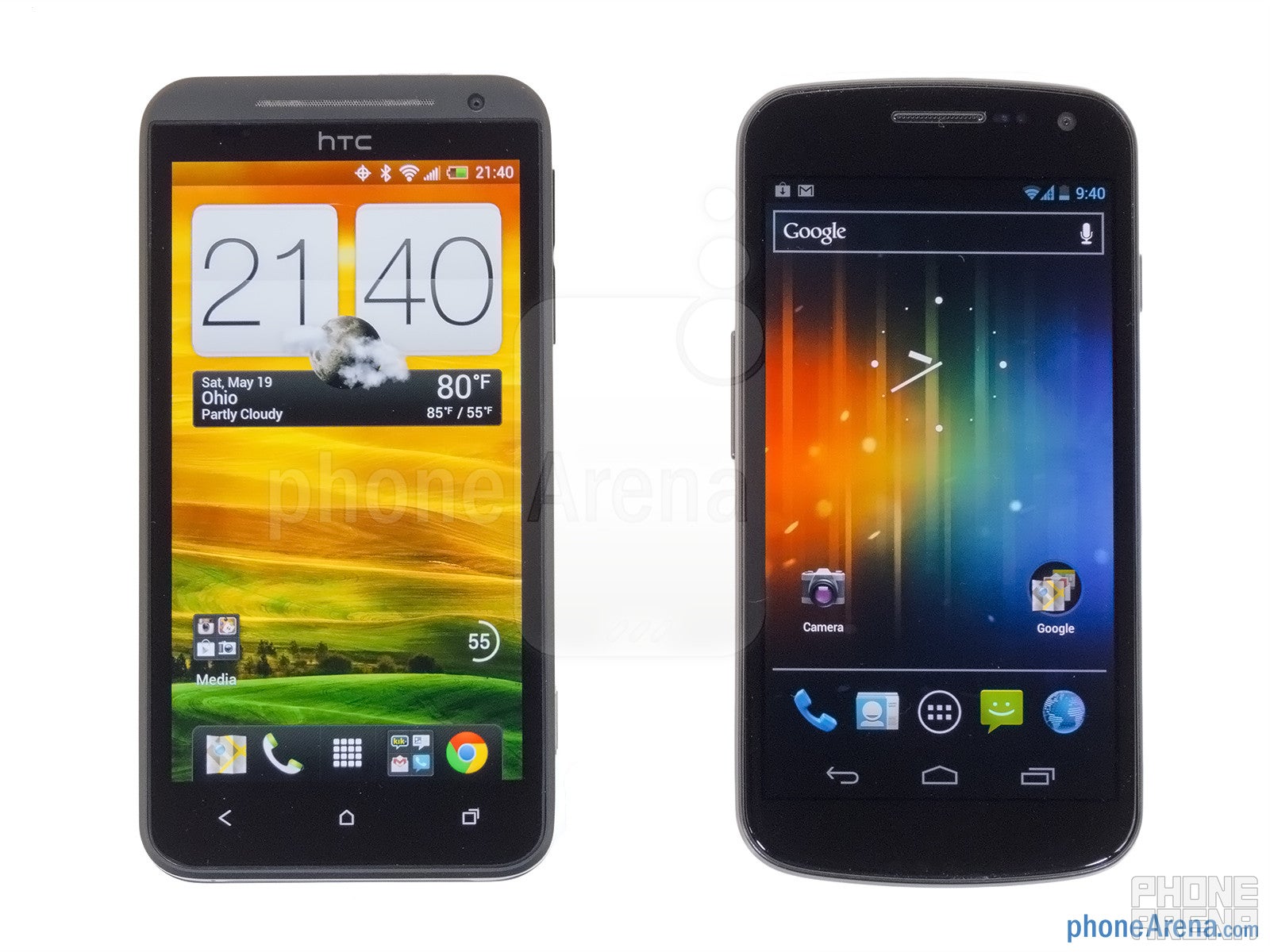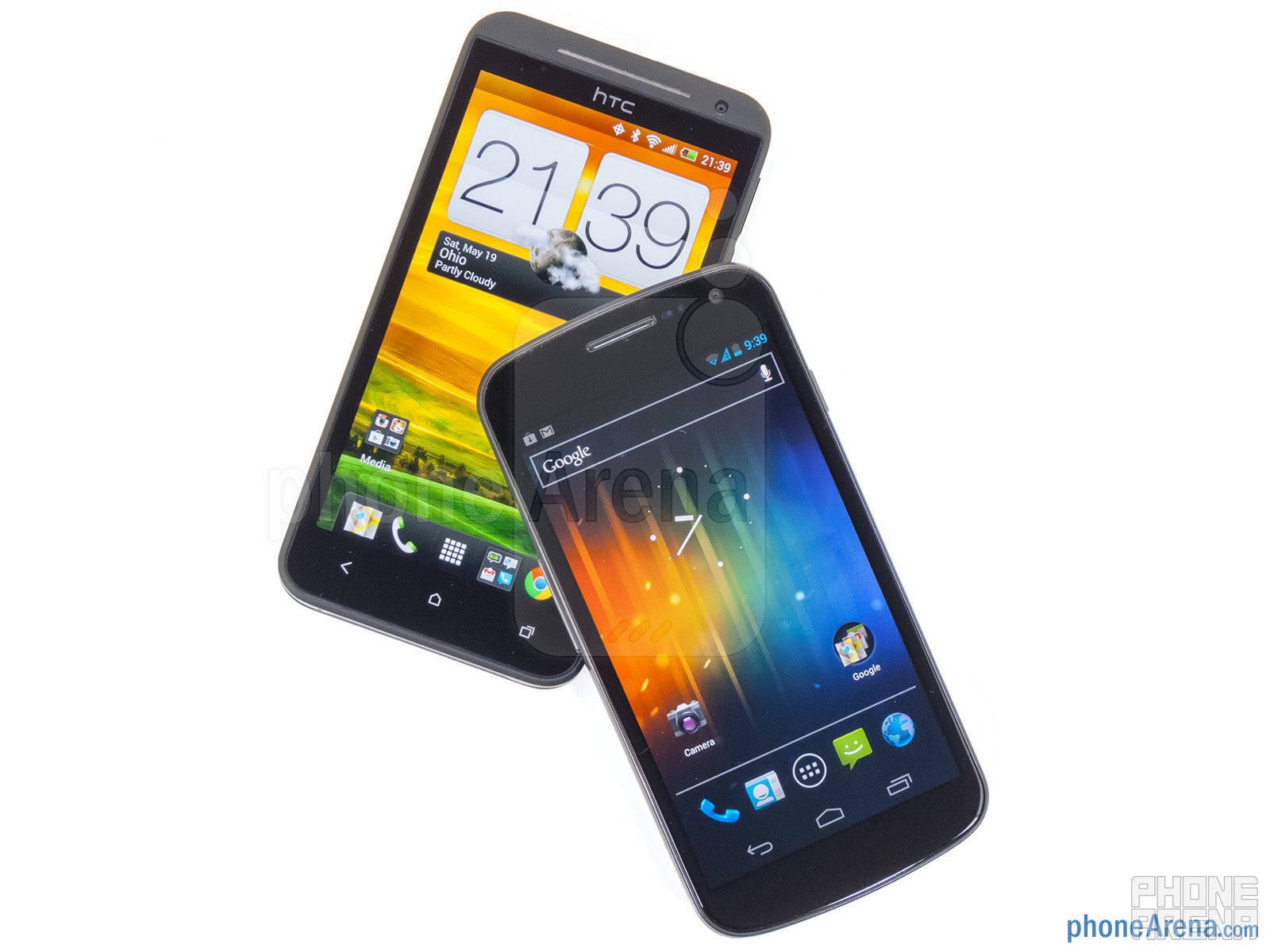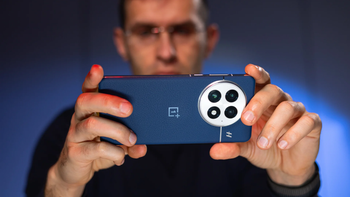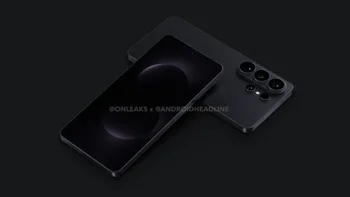HTC EVO 4G LTE vs Samsung Galaxy Nexus

Introduction:
Since the launch of the HTC Nexus One the Nexus line is what all Android phones have been measured against. The flagship Nexus represents Android in its purist form: the latest software directly from Google. Currently that flagship device is the Galaxy Nexus, the launch device for Android 4.0 Ice Cream Sandwich that hit Verizon’s shelves and LTE network in November. With an impending launch of their own LTE network Sprint has brought the latest Nexus to their lineup as well, but will the flagship Android device be the flagship phone for the pin dropping network? Not if HTC has anything to say about it with the latest member of the EVO family, the EVO 4G LTE. Read on to see how these competing devices compare.
Design:
Even though the EVO 4G LTE and the Galaxy Nexus are both dominated by their similarly large displays (4.7” and 4.65”, respectively) the two devices actually look pretty different. In fact, for black phones with such similar specs all around HTC and Samsung have managed to produce two devices that look and feel different entirely.
The buttonless Galaxy Nexus is literally a black slab, with only the black speaker grill and semi-hidden front camera breaking the monotony. The glass covers the entire face of the phone, and while it is not Gorilla Glass, Samsung does use a fortified glass that appears to perform well. The three gold dots on the right side allow for contact charging, as well as smart actions when docked. It is an awesome feature we wish more manufacturers used (interestingly the HTC One X has it but the feature was dropped on the EVO 4G LTE.) The Galaxy Nexus’s monotony continues as you flip it over, revealing a nearly all-encompassing gunmetal gray plastic housing. The black camera casing is offset by silver trim, and at the bottom of the Galaxy Nexus sits the single speaker. The textured back is wholly uninspired, and in fact is almost identical to the Galaxy S II.
To the contrary, the EVO 4G LTE really shows its personality through design. Around back a bright red band separates the piano black top third of the EVO with the matte black bottom. The phone’s kickstand is housed in this band, popping out to let you stand the phone in any of three directions. The camera is trimmed in the same iconic red as previous flagship EVO devices. The EVO 4G LTE uses an aluminum unibody design, most of which is anodized to the matte black finish, but along the sides HTC has milled the aluminum down to its natural silver, providing a smart and sharp contrast of colors. The housing wraps around the very top above the 4.7” display, encompassing the silver speaker grill. At the bottom of the display sit three capacitive buttons.
Slightly thinner and narrower than the Galaxy Nexus, the EVO 4G LTE feels better to hold in your hand. The cold aluminum gives a premium feel to the device that the Galaxy Nexus’ plastic just can’t match. We appreciate the microUSB port being on the bottom of the Nexus versus the side of the EVO, but in the grand scheme of things that is a small measure. The EVO’s use of Gorilla Glass 2 means it can be lighter but just as strong, likely a source of the weight difference between the two handsets. It is odd and possibly a figment of our imagination, but the EVO 4G LTE also feels better to interact with for some reason. We haven’t been able to place our fingers on just what it is, but it is something that we noticed the minute we took the EVO 4G LTE out of the box and something we still feel as we switch between our various devices.
Beauty is in the eye of the beholder, but to us the EVO 4G LTE wins the design contest and it’s not even close. It is thinner, lighter, made with premium materials and HTC has shown personality in the design, rather than just recycling an old handset. The EVO feels better to use, and the fantastic kickstand is icing on the cake.
Display:

Samsung uses their own Super AMOLED HD technology to produce tremendously vivid colors and equally deep blacks. HTC has turned to Super LCD2 tech for the screen on the EVO 4G LTE, and they made a wonderful choice. S-LCD2 incorporates IPS technology for superior viewing angles and brightness with excellent quality. Both AMOLED and S-LCD2 suffer from color oversaturation, but the S-LCD2 panels tone it down considerably while retaining the deep black levels. Both are amazing displays and we wouldn’t complain about either, but if we were choosing we’d take S-LCD2.
HTC EVO 4G LTE 360-degrees View:
Samsung Galaxy Nexus 360-degrees View:
User Interface:
Both the Samsung Galaxy Nexus and HTC EVO 4G LTE run off Android 4.0 Ice Cream Sandwich, but HTC uses their Sense skin whereas the Galaxy Nexus is of course pure Android. We’re not going to debate the merits of which UI is better; at this point Android can stand on its own just fine but we realize manufacturers must offer a compelling reason to choose their phone over a competitors with similar hardware and the same base software. What we will say is that Sense 4.0 is scaled back from previous versions, blends better with the ICS ideology and runs as smooth as stock Android does on the Nexus. For the first time in a long time we- as power users- actually enjoyed using Sense and weren’t pining for an ASOP ROM on the EVO 4G LTE.
Processor and Memory:
Samsung uses a 1.2GHz dual core TI OMAP4460 processor, while EVO 4G LTE is powered by a dual core Qualcomm S4. Both run on 1GB of RAM. The Samsung opts for 32GB of internal storage, whereas HTC only offers 16GB built-in but has expandable memory for another possible 64GB. HTC also partnered with Dropbox to give users activating an EVO 4G LTE 25GB of free cloud storage. Both run the OS quickly and fluidly, and in everyday use it is likely that you wouldn’t notice much of a difference. There is something to be said for the heavy graphical load of Sense 4.0 and how well the EVO 4G LTE handles it.
When it comes to benchmarks, however, the EVO 4G LTE mops the floor with the Nexus. Besting our previous scores, the EVO 4G LTE was able to achieve just shy of 5500 on Quadrant Standard, with the Galaxy Nexus topping out just over 2000 at its best. Nenamark 2 gave similar results, with the EVO 4G LTE topping out at 58.8fps and the Galaxy Nexus less than half that 24.9fps. On AnTuTu the EVO 4G LTE maxed out a few points shy of 7000, with the Galaxy Nexus far behind at about 5100 (with the rest of its scores down in the mid 4000s.) It is pretty clear that Qualcomm’s latest and greatest is up the challenge of some heavy computing.
| Quadrant Standard | AnTuTu | NenaMark 2 | |
| HTC EVO 4G LTE | 5459 | 6973 | 58.8 |
| Samsung Galaxy Nexus Sprint | 2021 | 5137 | 24.9 |
Connectivity and Internet:
Both phones offer a myriad of connection options, starting with LTE for high speed cellular data. With LTE unavailable as of now, they utilize Sprint’s EVDO Rev. A network. Both offer Wi-Fi a/b/g/n, GPS, NFC and Bluetooth, though the HTC features v4.0 while Samsung uses v3.0.
Both stock browsers had their strengths and weaknesses, but overall they performed very similar. Stock browsers are almost a moot point, since there are better options in the Play Store anyway. Google Chrome Beta ran wonderfully on both devices and is our current Android browser of choice.
Camera:
A reworked camera app was one of the selling points of Android 4.0, and we have to say we’re impressed with the instant capture feature that the Galaxy Nexus offers. The interface is better, but still clunky and worlds behind the HTC interface found on the EVO 4G LTE. The technology behind the Nexus’ camera is also lagging behind; Samsung opted for a 5 megapixel f2.8 camera while HTC went with an 8 megapixel f2.0 with backside illumination. Both are capable of producing some great shots, and at times the Galaxy Nexus bested the EVO 4G LTE, but the majority of the time the HTC outperformed the Samsung.
Colors were more natural with the EVO 4G LTE, details were crisper and tricky lighting conditions were handled much better. The Galaxy Nexus struggled with color saturation, backlight situations and light/dark contrast (such as shooting shadows.) The EVO 4G LTE bested the Galaxy Nexus especially indoors, where the latter had a tendency to lose details quickly, as evidenced by the pantry shot.

HTC EVO 4G LTE

Samsung Galaxy Nexus
Panorama
Both devices had some struggles shooting video. The HTC exhibited the same sound issues we found on our initial review (the C in HTC was cut out) although it did slightly better switching focus from far to near field. The Galaxy Nexus took a moment to get its own noise situation under control (despite what it sounds like, our sample video was not shot on a windy day) and had serious focusing issues when we moved from the sky back to the trees and to the EVO in our hand.
HTC EVO 4G LTE Sample Video:
Samsung Galaxy Nexus Sample Video:
Multimedia:
Much like the browser, the multimedia experience can be almost identical on these two devices thanks to the open nature of Android and the Play Store. The EVO 4G LTE has a software advantage thanks to HTC’s Beats Audio, which produces great sound when played through the headset. Videos look wonderful on the pair of large, vivid displays. You really can’t go wrong with either of them, but if we had to we’d choose the EVO 4G LTE thanks to the better display technology and slightly larger size.

Callers maintained that the EVO 4G LTE was the best phone we’d ever tested (and that’s without the HD audio the device is capable of) and we felt the same, so the Galaxy Nexus faces some stiff competition. For its part the Galaxy Nexus did well, and callers were overall pleased with the results. They said we sounded as if we were standing about 20 feet into a cave, but they were still able to hear us clearly. We also thought they sounded a bit hollow, but the speaker had plenty of volume and their voice was crisp and clear. These are no doubt two of the better performing phones available from Sprint right now.
HTC has given no ratings for the 2000mAh battery found on the EVO 4G LTE, but we’ve been pleasantly surprised at our ability to get through the day with plenty of juice remaining. The Galaxy Nexus’ 1850mAh battery is rated for a stout 12h of talk time, and we got through the day with it just fine as well. The slight edge goes to the Galaxy Nexus since it has the ability to swap batteries in a pinch.
Conclusion:
These are undoubtedly the two best Android devices Sprint has to offer, and really are two of the best smartphones available today. Some of this is going to come down to preferences, for example Sense versus stock or AMOLED versus S-LCD. All things considered the HTC EVO 4G LTE was the better performer of the pair in our opinion. It offers a superior display, top notch performance, excellent call quality and has an inspired design. The Galaxy Nexus is not without merit, and we would certainly carry one as our everyday phone if one were handed to us, but given the choice the HTC edges out the Nexus in too many categories to call it even.
EVO 4G LTE
Software: 1.13.651.1 710RD
Android 4.0.3
Sense 4.0
Galaxy Nexus
Android 4.0.4
Build Number: IMM76D.L700FD02
HTC EVO 4G LTE vs Samsung Galaxy Nexus:
Follow us on Google News













Things that are NOT allowed:
To help keep our community safe and free from spam, we apply temporary limits to newly created accounts: